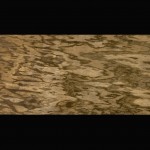8027a A VERY RARE PAIR OF VENEERED LEGNO SILICIZZATO TABLE TOPS Probably Italian. Eighteenth Century. Measurements: Length: 47 1/2″ (120.7 cm) Width: 23″ (58.4 cm) Thickness: 1 1/8″ (2.9 cm).

Research
Veneered with legno silicizzato. Old repairs.
The present pair of veneered tabletops is a fine example of the use of legno silicizzato, or silicified wood, in furniture. These fossils, which usually date from the late Triassic period (around 200 million years ago), were prized for having the strength typical of hardstones, along with the well-preserved and attractive appearance of their original plant form. The extremely slow process by which the wood is silicified, replacing their organic cells with minerals over a period of millions of years, results in an opaque or translucent stone with a recognizable grain pattern, in colors ranging from white to shades of brown or green.
The unmistakable wood patterns in specimens of legno silicizzato undoubtedly contributed to their use in early furniture, for scientific interest as much as for their decorative appeal. One known early example of a table made from silicified wood was owned by Prince Federico Cesi, who founded the underground scientific society L’Accademia dei Lincei in Rome in 1603.1 Members met at Cesi’s palace in Via della Machera d’Oro to discuss scientific matters and the publication of their studies, including the infamous Il Saggiatore by member Galileo Galilei in 1623. One member named Cassiano Dal Pozzo, who was committed to continuing the Accademia founder’s work after Cesi’s death in 1603, purchased Cesi’s estate, including the table made of fossilized wood, which he sent to his friend George Ent in England around 1636. Ent, a noted physician and member of The Royal Society of London, took the table to the Society’s early meetings, where it is said to have contributed to the group’s debate on the origin of fossils.2
One of the most famous examples of a fossilized wood tabletop is found on a gueridon in the collection of the Palais de Versailles.3 This table, sent in 1770 as a gift to the Dauphine Marie-Antoinette from her sister Maria Christina, was designed to hold a top of fossilized wood which had previously been in the collection of King Charles I of England, whose brand can still be found on the underside of the top. As in the present pieces, the top in Versailles was made from a slab that had been cut along the grain of the fossilized wood, rather than across the grain. Marie-Antoinette’s tabletop is ornamented with marble inlay, and cut to conform to the shape of the ornate table, while the present tops feature their pleasing and undisturbed grain pattern without further adornment.
The present pair of tops were formerly in the iconic collection of Lord Robert Abdy (1896-1976) and Lady Jane Abdy (née Noble, 1934-2015). The couple were renowned connoisseurs, collectors and art dealers, who staged numerous Belle Époque and Art Nouveau exhibitions at the Ferrers Gallery in Piccadilly Arcade, and kept the company of such distinguished intellectuals, artists, and writers as Gertrude Stein, Cecil Beaton, and James Reeve. They resided both in London and at Newton Ferrers, a 17th-century country house in Cornwall that Abdy had acquired in 1936. After Lord Abdy’s death in 1976, Jane Abdy continued to work as a private art dealer, as well as a buyer for a member of the Saudi Royal family. Her taste was of the utmost sophistication with an emphasis on the esoteric.
Footnotes:
- “History.” 2007. Accademia Nazionale dei Lincei. 26 March 2009. <http://www.lincei.it/modules.php?name=Content&pa=showpage&pid=21>
- Cook, Sir Alan. “A Roman Correspondence: George Ent and Cassiano dal Pozzo, 1637-55.” Notes & Records of the Royal Society (of London). Vol. 59, No. 1. 22 January 2005. 5.
- Meyer, Daniel. Versailles: Furniture of the Royal Palace, 17th and 18th Centuries. Vol. 1. Éditions Faton, Dijon, 2002. 216-7.


Comments are closed.